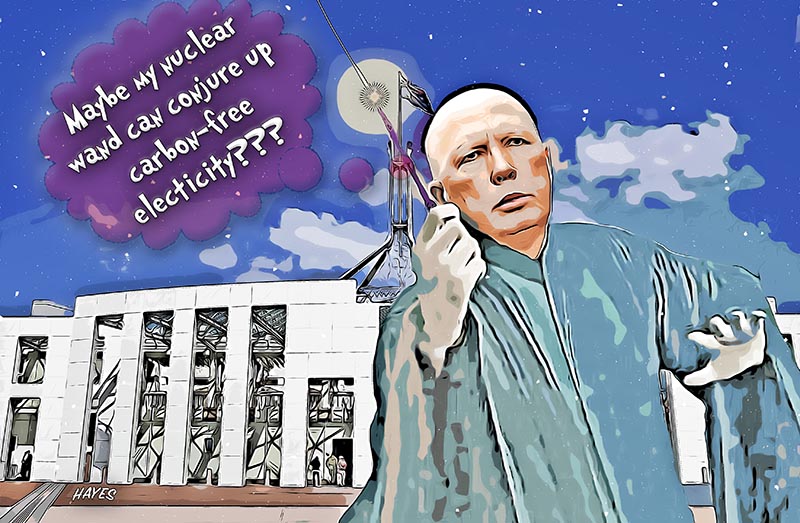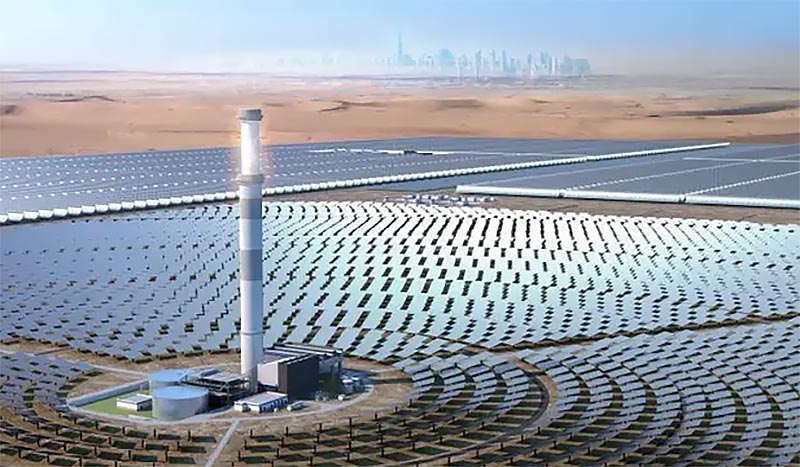
Dutton’s nuclear madness
Peter Dutton talking the talk on nuclear power as the saviour of the energy crisis will appeal to the LNP base, but it won’t appeal to those concerned about the cost of living – there is a lack of leadership and vision. But is the Federal Government’s answer - a mix of wind, solar and coal and gas – any better?

Nuclear power is not the saviour to our energy crisis and waving a magic wand, no matter how hard you try, will not change the fact that a nuclear power plant is not carbon-free and carries serious safety concerns, including contaminating the environment with radioactive dust, radon gas, water-borne toxins, and increased levels of background radiation.
20 March 2024
ALAN HAYES
DESPITE the need to shift from carbon-based fuel, the federal government still panders to the coal and gas mining industry. Why? Because successive governments have turned the once clever country, who rode to wealth on the sheep’s back, into a gigantic mine pit, allowing the mining industry to destroy our valuable agricultural lands.
So, is Peter Dutton’s nuclear dream the silver bullet to the energy crisis? The Coalition began calling for a “mature debate” on nuclear immediately after losing office, but Dutton’s ‘nuclear folly’ is more about getting re elected than solving the energy crisis with clean, reliable and affordable electricity for struggling households.
The reason why a ban on nuclear power was introduced in every Australian state and territory was because of community concerns about health and the environment risks. Yet the prospect of nuclear power in Australia has been a topic of public debate since the 1950s. Periodically, however, as with the changing of the seasons, various individuals appear in the media singing the virtues of nuclear energy – claiming it is the only option for clean and reliable electricity in Australia. It’s now become Peter Dutton’s turn!
Currently, more than one third of Australia’s electricity is already powered by renewables – we do not need distractions like nuclear to derail the progress. But renewables alone, and battery and capacitor storage, is not the magic solution – solar panels and battery storage are great as a home energy system but we still require reliable base-load power.
Dutton’s 'nuclear madness; is fraught with problems – it’s extremely expensive and takes a long time to build a power station. Just the approvals alone can run into twelve years, then another ten to complete the power plant. Even when a nuclear power station operates as intended, it creates a long-term and prohibitively expensive legacy of site remediation, fuel processing and radioactive waste storage.
Just like coal, oil and gas, uranium is a finite resource. It needs to be mined and, just like mining coal, oil and gas, this carries serious safety concerns, including contaminating the environment with radioactive dust, radon gas, water-borne toxins, and increased levels of background radiation. So, if Peter Dutton thinks that he can wave a nuclear wand to produce carbon-free, inexpensive energy, he is living in fantasy land.
Dutton isn’t interested in climate change, he isn’t interested in good policy and he isn’t interested, it would seem, in legislation that outlaws the building of nuclear power plants in Australia - the Australian Radiation Protection and Nuclear Safety Act 1998 and the Environment Protection and Biodiversity Conservation Act 1999 both prohibit the approval, licensing, construction, or operation of a nuclear plant.
Why was legislation introduced to ban nuclear power plants? Because of the creation of radioactive wastes, such as uranium mill tailings, spent (used) reactor fuel, and other radioactive wastes. These materials can remain radioactive and dangerous to human health for thousands of years – when there is a malfunction it can be catastrophic.
So, after 9 years of energy policy chaos, rather than finally embracing a clean, cheap, safe and secure renewable future, all the Coalition can promise is a multi-billion dollar nuclear flavoured energy policy.
Dutton’s nuclear folly is the ‘classic dead cat’! It’s designed to do nothing more than to distract voters away from the Coaltion's hatred for wind and solar power, and from the fact that real action is needed and that the Coalition's fantasy has a $387 million price tag on it.
But is Chris Bowen’s feverish push for solar, wind and batteries the answer, while phasing out coal and gas, without any real direction as to what will replace it for 24/7 base-load power, any better than ‘Dutton’s folly’?
The reality is we need base-load power for a reliable grid system that will cater for industry and domestic electricity. We need base-load technologies that are carbon-free and do not create green-house gases, such as hydro, pumped-hydro and molten salt. Yet Chris Bowen and the Albanese Government seem to have their heads completely buried in mounds of salt when it comes to molten salt technology – concentrated solar thermal energy (CSP).

Concentrated solar thermal power plants, which have no greenhouse gas emissions, can replace coal and gas for base-load power into the grid and are less expensive to build than nuclear power.
So, how does CSP technology work? CSP technologies use mirrors to reflect and concentrate sunlight onto a receiver. The energy from the concentrated sunlight heats a high temperature fluid in the receiver – in most cases critically super-heated salt, which becomes fluid, if used. This steams water circulating through the receiver, which drives a steam turbine connected to an electrical power generator. As the steam driving the turbine cools and condenses it is captured in a cooling tower and returned to the system, to be once again super-heated.
The advantage of CSP is that it provides endless amounts of energy, 24/7, no CO2 emissions during operation and reduces our dependency on fossil fuel.
Dominic Zaal, Director, Australian Solar Thermal Research Institute - Energy Group at CSIRO – said “Australia will need Concentrated Solar Thermal Power (CSP) if it is to come anywhere close to having a net-zero economy.
“CSP is one of the lowest cost technology pathways to provide firm renewable power overnight - namely for the 10-12 hours every day when the sun isn't shining.
“CSP, along with other long-duration intraday renewable storage technologies, will be essential for Australia's energy transition - particularity for grid connected power generation and for Australia's mining sector.”
Currently AGL are building a super-battery, for $785 million, on the old Liddell power station site, so the Grapevine asked Mr Zaal “what size CSP plant could you build for that money?”
Mr Zaal confirmed that “you could build a 100-megawatt power plant.”
A 100-megawatt power plant is not enormous but it would provide continuous base-load power into the existing grid. The AGL super-battery will only provide power to 60,000 homes during two hours of the evening peak period. It would have a life-span of fourteen years, whereas the CSP plant would be around 50 years, similar to that of a coal-fired power plant.
CSP plants are less expensive to build than coal or gas generation plants and don’t come anywhere near the cost and time to build a nuclear power plant.
Around the world CSP is being adopted at fierce rate. In the United States (US) the state of California is entirely powered by CSP, three other US states have CSP plants; Spain has 27; Israel has 6; India has 6; China has 6; there are also CSP plants in the UAE, Saudi Arabia, South Africa and Chile.
So, why hasn’t Australia, a sunburnt country with an abundance of space, moved apace into this technology? Because the lack of common sense and lack of vision of our government shines through – the CSIRO already have a pilot plant in Newcastle. Yet the Newcastle plant doesn’t service the grid – it just sits there as a pilot plant, while our politician’s pontificate how to solve the energy crisis and bring Australian into a net zero economy.
Ironically, in 2017 and 2018 Prime Minister Malcolm Turnbull was working up a National Energy Guarantee (NEG) policy to deliver energy to Australia, which balanced out cost, reliability and emissions cleanliness – a move away from coal and gas, without the need for nuclear power. It was policy designed by engineers and economists. Yet Peter Dutton moved to exploit deep seated division in the Liberal National Party (LNP) to can the proposal. A second challenge to Turnbull’s clean energy policy saw Scott Morrison sworn is as Prime Minister and the NEG abandoned.
Real change and real leadership is needed now to eliminate our fossil fuel dependency. We don’t need Dutton’s nuclear madness nor do we need Bowen’s ‘Galah-style-indecision’ – we need decisive action before it’s too late.







.jpg?crc=4257584689)










_web.jpg?crc=282450513)



